When you're looking to choose the right motorcycle, understanding engine types and specifications is key. You'll encounter various configurations like inline and V-twin engines, each with unique performance traits. It's crucial to know how metrics such as engine displacement and torque impact your ride. With this knowledge, you can match a bike to your riding style, but the details can be overwhelming. What should you prioritize, and how do these choices affect your overall experience? Let's break down the specifics that matter most.
Quick Takeaways
- Familiarize yourself with engine types: Inline, V-Twin, Single-Cylinder, and their unique characteristics to match your riding style.
- Understand engine displacement, as it influences power output, responsiveness, and fuel efficiency, impacting overall riding experience.
- Learn about performance metrics like horsepower, torque, RPM, and power band to gauge a motorcycle's capabilities.
- Differentiate between four-stroke and two-stroke engines; each offers distinct advantages in power delivery and efficiency.
Overview of Suzuki Motorcycles
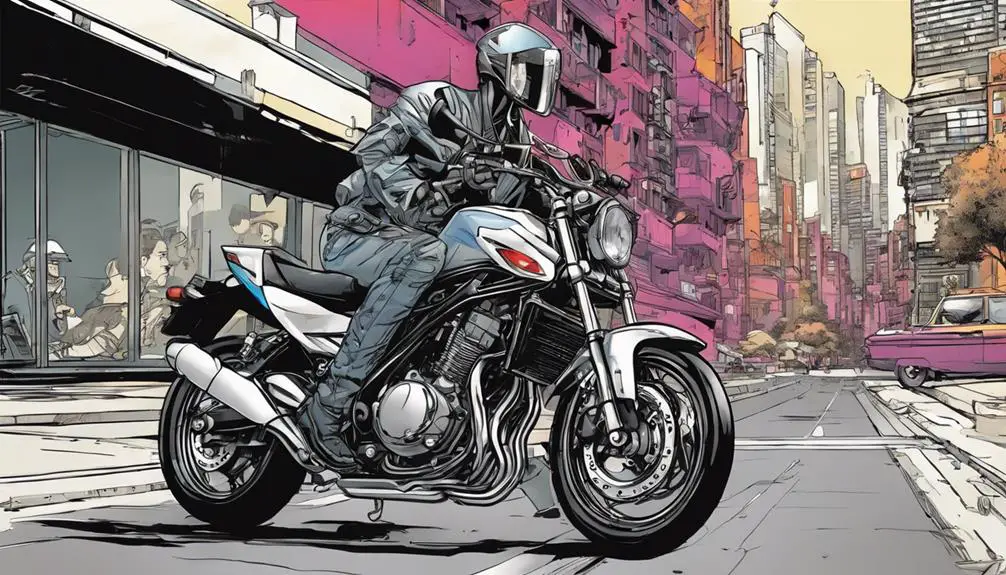
Suzuki motorcycles consistently deliver a blend of performance, reliability, and innovation that appeals to riders of all levels. Whether you're cruising through city streets or tackling winding backroads, you'll find a Suzuki that fits your style and spirit. Their diverse lineup includes everything from nimble sport bikes to rugged adventure models, ensuring you can choose a ride that resonates with your need for freedom.
The design philosophy behind Suzuki is all about empowering you to connect with the open road. Every bike is engineered with precision, allowing you to feel the rush of acceleration and the thrill of leaning into corners. You won't just be riding; you'll be experiencing a sense of liberation that comes from mastering the machine beneath you.
Moreover, Suzuki's commitment to innovation keeps you at the forefront of motorcycle technology. Advanced features enhance your riding experience, making each journey not just about getting from point A to B, but about embracing the adventure along the way.
Key Engine Types Explained
In this section, you'll explore the key motorcycle engine types that define performance and riding experience.
You'll learn about the unique characteristics of inline engines, the power of V-twin configurations, and the simplicity of single-cylinder designs.
Understanding these engine types will help you make better choices for your riding style.
Inline Engine Configuration
When it comes to motorcycle engines, the inline configuration stands out for its simplicity and efficiency, making it a popular choice among riders. This design typically features cylinders arranged in a straight line, which helps maintain a balanced weight distribution and lower center of gravity.
You'll often find inline engines in sportbikes and touring motorcycles, where smooth power delivery and high RPMs are essential.
Here are a few reasons why inline engines might ignite your passion for the open road:
- Smoother Power Delivery: Inline engines provide a linear power band, giving you a seamless riding experience.
- High RPM Potential: They usually rev higher than other configurations, allowing for exhilarating acceleration.
- Compact Design: Their straight-line layout maximizes space efficiency, making them ideal for sleek bike designs.
V-Twin Engine Characteristics
While inline engines are known for their smoothness, V-twin engines offer a distinct character and unique performance attributes that many riders find appealing. These engines deliver a throaty growl that resonates with the freedom-seeking spirit of motorcycling. With their two cylinders arranged in a V shape, they produce a strong torque at low RPMs, making them perfect for cruising on open roads.
You'll notice that V-twins have a more visceral feel compared to their inline counterparts. The uneven firing order creates a pulsating power delivery, giving you an exhilarating ride that connects you to the machine. This engine type is often favored for its simplicity and low maintenance, allowing you to focus on the thrill of the journey rather than the hassle of upkeep.
Additionally, V-twins come in various configurations, including the classic 45-degree and the more modern 90-degree designs. Each offers its own personality and performance characteristics, letting you choose an engine that aligns with your riding style.
Whether you're carving through twisty mountain roads or cruising down the highway, a V-twin engine invites you to embrace the open road and live life on your terms.
Single Cylinder Overview
Single-cylinder engines stand out for their simplicity and lightweight design, making them a favorite among beginners and off-road enthusiasts alike. These engines offer an exhilarating experience, allowing you to connect deeply with your bike while mastering the art of riding. They're often more affordable and easier to maintain, freeing you from the complexities of heavier machinery.
Here are some key features of single-cylinder engines:
- Lightweight: Their compact size enhances maneuverability, perfect for agile rides.
- Fuel Efficiency: With fewer moving parts, they consume less fuel, allowing longer journeys.
- Easy Maintenance: Simplified design means you can tackle basic repairs without specialized knowledge.
Riding a single-cylinder motorcycle encourages a sense of liberation. You're not just riding; you're becoming one with the road, feeling every twist and turn.
Whether you're guiding through city streets or exploring rugged paths, these engines offer a unique thrill that empowers you to embrace the journey.
Engine Specifications Breakdown
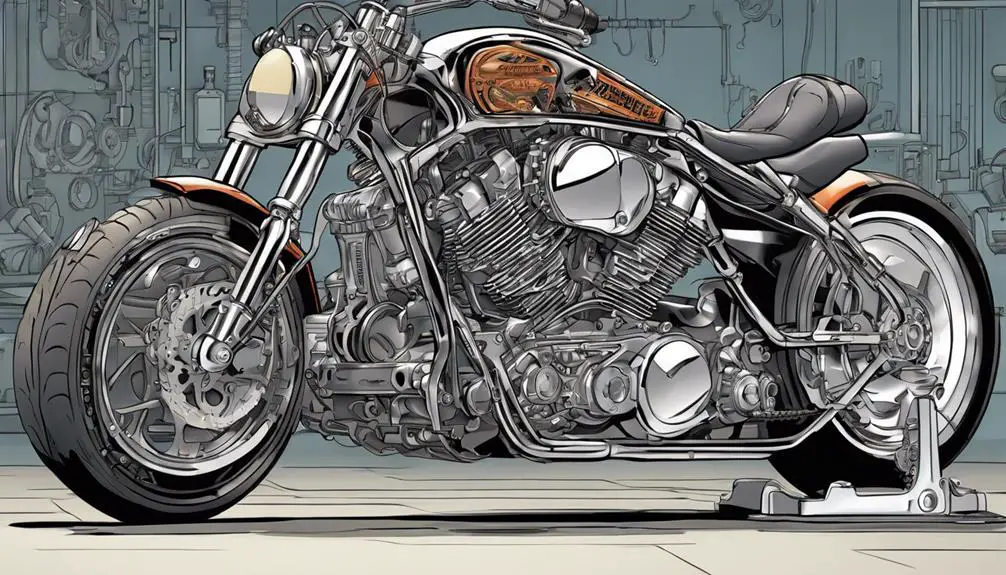
When it comes to motorcycle engines, understanding the specifications can really enhance your riding experience.
You'll want to contemplate engine configuration types, displacement, and how these factors affect performance and power output.
Let's break down these key points to help you make informed decisions about your ride.
Engine Configuration Types
Motorcycle engines come in various configurations, each offering unique performance characteristics and riding experiences that cater to different preferences. Understanding these configurations can empower you to choose the perfect ride for your freedom-seeking spirit.
- Single-Cylinder: Lightweight and nimble, perfect for city riding and beginners.
- Parallel-Twin: A balanced option that delivers good torque and smoothness, ideal for everyday commuting.
- V-Twin: Known for their rich sound and strong low-end torque, these engines are favored by cruisers and touring bikes.
Each engine type has its own charm and character, influencing how you connect with the road.
Whether you crave the raw simplicity of a single-cylinder or the refined power of an inline-four, there's a configuration that aligns with your riding style.
As you explore these options, you'll find the engine that resonates with your desire for adventure, allowing you to release your inner rider.
Embrace the journey and let the engine configuration guide you toward the freedom of the open road.
Displacement and Performance
Understanding engine displacement is essential, as it directly impacts a motorcycle's performance, responsiveness, and overall riding experience. Displacement refers to the total volume of all the cylinders in an engine, usually measured in cubic centimeters (cc) or liters. A higher displacement typically means more power, but it's not just about raw numbers.
When you twist the throttle, a larger engine can deliver more torque, allowing you to accelerate faster and climb hills with ease. This can make your rides feel more liberating, giving you the freedom to conquer diverse terrains with confidence. However, keep in mind that a bigger engine may also mean increased weight and fuel consumption. You'll want to balance your desire for power with the practicality of handling and efficiency.
Smaller displacement engines, on the other hand, often provide nimble handling and better fuel efficiency, making them perfect for city riding. They can also offer a different kind of thrill, letting you rev high and enjoy the sound and feel of the bike without the weight.
Ultimately, the right displacement for you depends on your riding style and the adventures you seek.
Power Output Metrics
Power output metrics, like horsepower and torque, play a significant role in determining how your motorcycle performs on the road, complementing the insights gained from engine displacement. Understanding these metrics helps you gauge your bike's capabilities and potential for thrilling rides.
- Horsepower measures how quickly your engine can perform work, influencing your bike's top speed.
- Torque reflects the twisting force your engine generates, impacting acceleration and responsiveness, especially in lower gears.
- RPM (Revolutions Per Minute) indicates how fast your engine spins, affecting both horsepower and torque delivery.
Four-Stroke Vs. Two-Stroke
When comparing four-stroke and two-stroke engines, you'll find distinct differences in performance, maintenance, and overall riding experience.
Four-stroke engines, often favored for their efficiency, deliver smoother power and better fuel economy. They go through a complete cycle of intake, compression, power, and exhaust, which means they produce less pollution and noise. If you're looking for a reliable ride that requires less frequent maintenance, the four-stroke might be your go-to option.
On the flip side, two-stroke engines provide exhilarating power and a lightweight design, giving you that raw, unbridled freedom on the road or track. They fire once every revolution, resulting in a more immediate throttle response, perfect for those who crave excitement. However, this comes at a cost—higher fuel consumption and increased emissions.
Ultimately, your choice depends on what you value in your ride. If you prioritize efficiency and reliability, a four-stroke engine suits you. But if you're seeking thrill and a lightweight feel, a two-stroke engine may set your spirit free.
Embrace the ride that resonates with your passion and lifestyle!
Inline Engines Characteristics
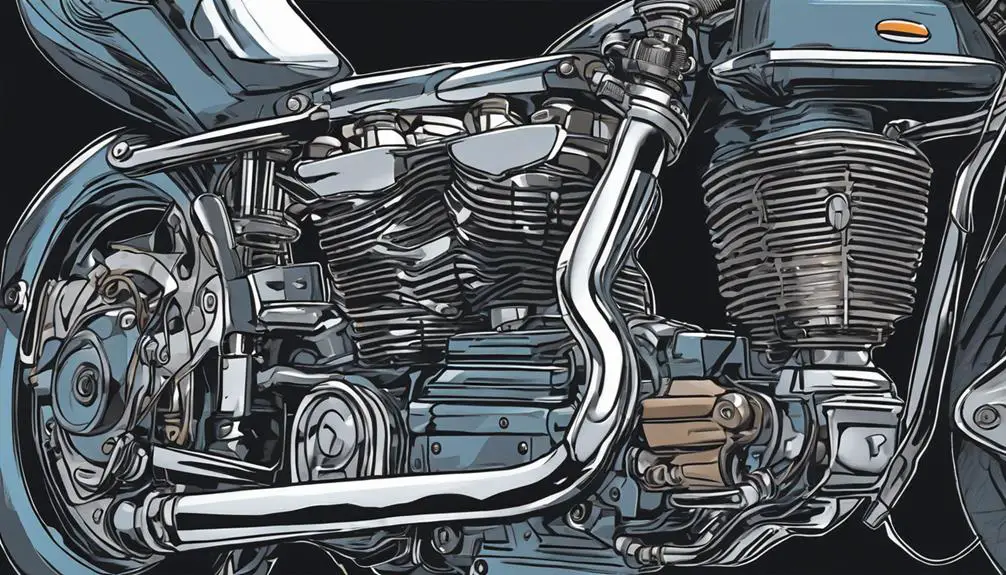
Inline engines are known for their balanced performance and smooth operation, making them a popular choice among motorcycle enthusiasts. These engines feature a straight configuration, allowing for efficient power delivery and a responsive ride. You'll appreciate how they provide a harmonious blend of power and control, ideal for both city cruising and long-distance touring.
Here are some key characteristics of inline engines:
- Smoother Operation: The linear arrangement of cylinders reduces vibration, giving you a more comfortable ride.
- Higher RPM Range: Inline engines often excel in high RPM performance, allowing for thrilling acceleration when you want it.
- Compact Design: Their design allows for a smaller footprint, making them easier to fit in various bike frames.
With these attributes, inline engines cater to riders who crave freedom on the open road.
Whether you're slicing through city streets or tearing up winding country roads, an inline engine can elevate your riding experience to new heights.
Enjoy the liberation of the ride!
V-Twin Engine Insights
V-twin engines are celebrated for their distinctive rumble and robust torque, making them a favorite among riders seeking a unique and powerful experience on the road. When you throw your leg over a V-twin bike, you're not just riding; you're embracing a lifestyle that celebrates freedom and adventure. These engines, with their two cylinders arranged in a V-shape, deliver a thrilling torque curve that brings exhilarating acceleration right from low RPMs.
You'll find that V-twins excel in providing an engaging riding experience, particularly when it comes to cruising. The deep sound resonates with your spirit, giving you a visceral connection to the machine. Whether you're maneuvering through city streets or winding country roads, the power delivery feels smooth and responsive.
Another aspect worth noting is their versatility. V-twin engines are found in a range of motorcycles, from cruisers to sport-touring bikes, allowing you to choose the ride that fits your vision of freedom. As you explore, you'll appreciate how they balance power and control, making every ride feel like an adventure waiting to unfold.
Understanding Engine Displacement
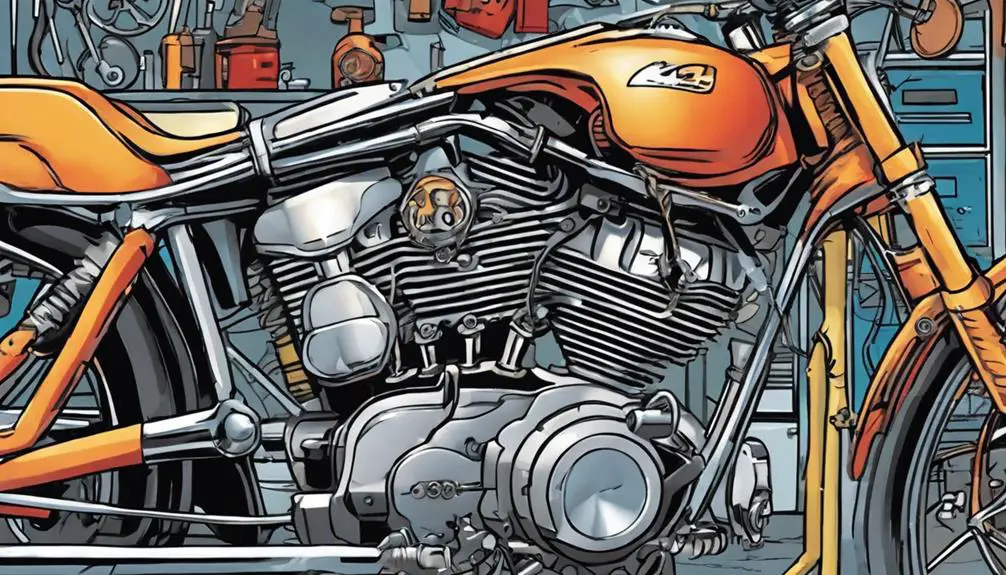
Engine displacement is an essential factor that influences a motorcycle's performance and power output, directly impacting how your bike feels on the road.
Simply put, it refers to the total volume of all the cylinders in the engine, measured in cubic centimeters (cc). The larger the displacement, the more air and fuel your engine can draw in, leading to greater power and acceleration.
Understanding displacement helps you choose the right bike for your riding style. Whether you crave speed on the highway or a smooth ride through the city, knowing what displacement offers can be liberating.
Here are a few key points to take into account:
- Power: Higher displacement usually means more horsepower, giving you that exhilarating rush.
- Torque: More cc can enhance torque, improving your bike's acceleration and responsiveness.
- Fuel Efficiency: Smaller engines may offer better fuel economy, perfect for daily commutes.
Performance Metrics of Suzuki Bikes
When it comes to Suzuki bikes, understanding their performance metrics is essential for any rider.
You'll want to compare engine displacement, analyze power output, and look at torque specifications to gauge their capabilities.
These factors will help you make an informed choice about which Suzuki model suits your riding style best.
Engine Displacement Comparisons
Comparing engine displacement in Suzuki bikes reveals key insights into their performance capabilities and riding experiences. Displacement, measured in cubic centimeters (cc), directly influences how a bike responds to your commands on the road. Whether you're cruising through the city or tearing up twisty backroads, understanding these metrics can enhance your ride.
- Small Displacement (125cc – 250cc): Ideal for beginners, these bikes are light and agile, offering easy handling and fuel efficiency.
- Mid Displacement (300cc – 650cc): Perfect for those seeking a balance between power and control, these bikes provide enough oomph for spirited rides without overwhelming the rider.
- Large Displacement (750cc and above): These beasts deliver raw power and torque, making them suitable for experienced riders who crave thrilling acceleration and long-distance touring.
Power Output Analysis
Analyzing the power output of Suzuki bikes reveals how their performance metrics can considerably enhance your riding experience.
When you twist the throttle, the raw power generated by Suzuki's engines propels you forward with exhilarating force. Whether you're cruising down the highway or slicing through city traffic, these bikes provide the freedom and responsiveness you crave.
Suzuki's lineup offers a variety of engine configurations, each designed to cater to different riding styles. From the nimble GSX-R series, which delivers impressive horsepower for spirited rides, to the more laid-back V-Stroms, designed for comfort while still packing a punch, you've got options that fit your lifestyle.
The power output isn't just about numbers; it's about how that power translates to the road. You'll feel the instant acceleration and smooth handling, giving you confidence to tackle any challenge. When you understand the power output, you can choose a Suzuki that aligns with your adrenaline-fueled desires or your leisurely weekend rides.
Ultimately, the right power output can turn an ordinary ride into an extraordinary journey, setting you free to explore the open road.
Torque Specifications Overview
Torque specifications play an essential role in how Suzuki bikes deliver power to the wheels, affecting acceleration and overall handling. When you rev the engine, it's the torque that provides that exhilarating push you feel as you take off. Understanding these specs helps you connect with your machine, revealing its full potential for an unforgettable riding experience.
Here's what you should know about torque on Suzuki bikes:
- Measured in Foot-Pounds (ft-lbs): Torque is quantified in this unit, giving you a clear picture of the bike's power delivery.
- Optimal RPM Range: Each Suzuki model has a specific RPM range where torque peaks, ensuring you know when to release that power.
- Impact on Throttle Response: Higher torque means quicker acceleration, making your rides more thrilling.
Common Engine Problems
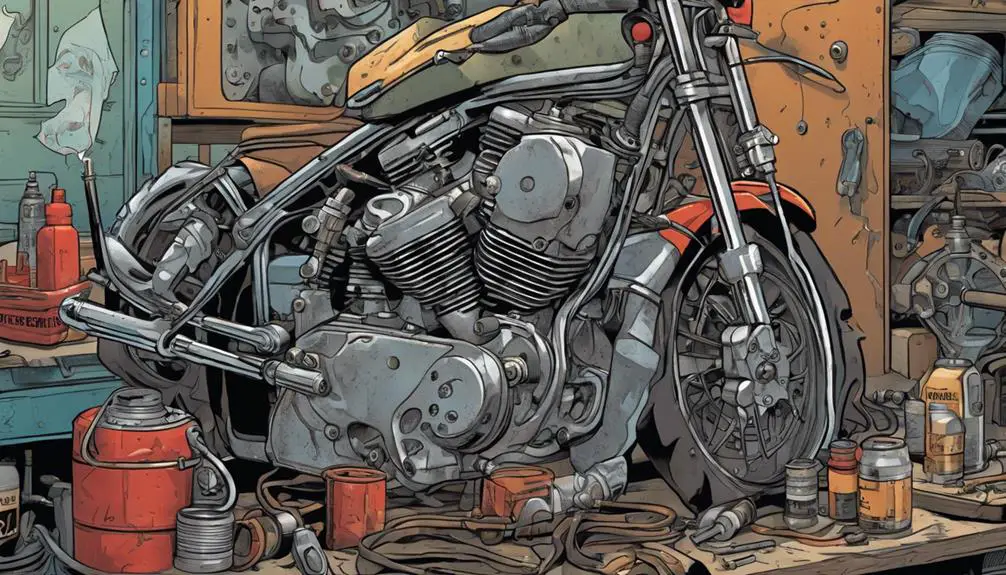
Many riders encounter common engine problems that can affect performance and safety on the road. One of the most frequent issues is poor starting, which can stem from a weak battery, faulty starter motor, or even a clogged fuel system. You don't want to be stranded, so always check these components.
Another common problem is overheating. This can happen due to low coolant levels, a malfunctioning thermostat, or a blocked radiator. If your engine runs hotter than usual, it's essential to address it immediately to prevent severe damage.
You might also experience unusual noises, like knocking or grinding sounds. These often indicate internal issues, such as worn bearings or insufficient lubrication. Ignoring these sounds can lead to catastrophic engine failure.
Lastly, watch out for excessive smoke from the exhaust. Blue smoke might mean oil is leaking into the combustion chamber, while white smoke could indicate coolant issues. Recognizing these signs early will empower you to take action and maintain your ride's freedom.
Maintenance Tips for Suzuki Engines
To keep your Suzuki engine running smoothly, regular maintenance is crucial for peak performance and longevity. You don't have to be a mechanic to perform basic upkeep on your bike, but staying proactive will guarantee you enjoy the freedom of the open road without unexpected hiccups.
Here are some straightforward tips to help you maintain your Suzuki engine:
- Change the oil regularly: Fresh oil not only lubricates but also cleans your engine. Aim for an oil change every 3,000 miles or as recommended in your manual.
- Check and replace filters: Replace air and fuel filters as needed to guarantee your engine breathes and runs efficiently.
- Inspect spark plugs: Worn spark plugs can lead to poor performance. Check and replace them if necessary to keep that power flowing.
Common Questions
How Do Riding Styles Affect Engine Performance?
Riding styles play a huge role in engine performance.
When you ride aggressively, your engine needs to respond quickly, demanding more power and torque.
Conversely, if you prefer cruising, the engine can run more efficiently at lower RPMs.
Your choice of riding gear and terrain can also impact how the engine performs.
What Role Does Fuel Type Play in Engine Efficiency?
Fuel type greatly impacts your engine's efficiency.
When you choose high-octane fuel, you might notice better performance and smoother acceleration. It allows your engine to run at peak levels, reducing knocking and improving combustion.
On the flip side, using lower-quality fuel can lead to a decline in power and efficiency.
Can Engine Modifications Impact Warranty Coverage?
Yes, engine modifications can definitely impact your warranty coverage.
When you alter your engine, manufacturers might see it as a reason to void your warranty, especially if the modification leads to damage.
It's essential to read your warranty terms carefully and consider consulting your dealer before making changes.
If you're seeking freedom in your ride, just remember that some modifications might come with risks that could affect your overall ownership experience.
How Do Weather Conditions Influence Engine Performance?
You'd think your engine loves sunny days, right?
But weather conditions can really mess with its performance.
Cold temperatures can thicken oil, making it harder for your engine to work smoothly.
On the flip side, excessive heat can cause overheating, leading to potential damage.
Humidity? It can affect air-fuel ratios, too.
What Are the Environmental Impacts of Different Engine Types?
When you consider the environmental impacts of different engine types, you'll notice that some engines emit higher levels of pollutants. For instance, two-stroke engines often produce more carbon emissions compared to four-strokes.
You'll want to think about fuel efficiency, too, as it directly affects your carbon footprint. By choosing cleaner technologies, like electric or hybrid engines, you can contribute to a healthier planet and enjoy the freedom of riding without the guilt of harming the environment.
Wrapping Up
In understanding motorcycle engine types and specs, you're not just choosing a bike; you're selecting a companion for your journeys, like picking a trusted friend for an adventure.
By familiarizing yourself with different engines, their specifications, and maintenance tips, you can guarantee a smoother ride and a deeper connection with your machine.
So, gear up and embrace the thrill of the open road, knowing you've made an informed choice that suits your riding style perfectly.